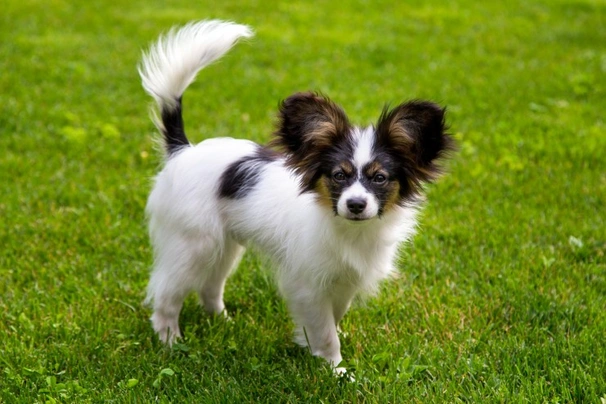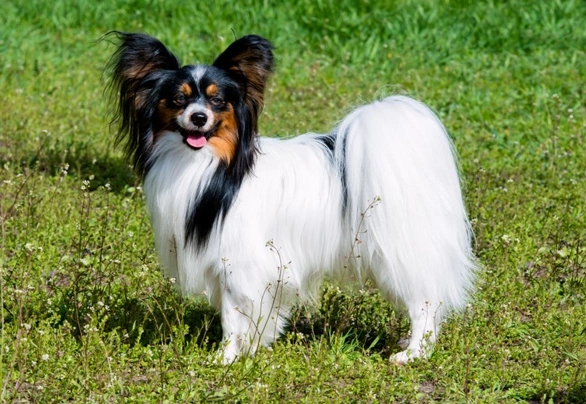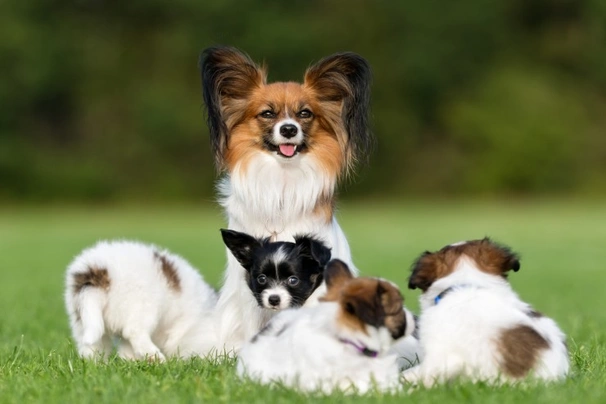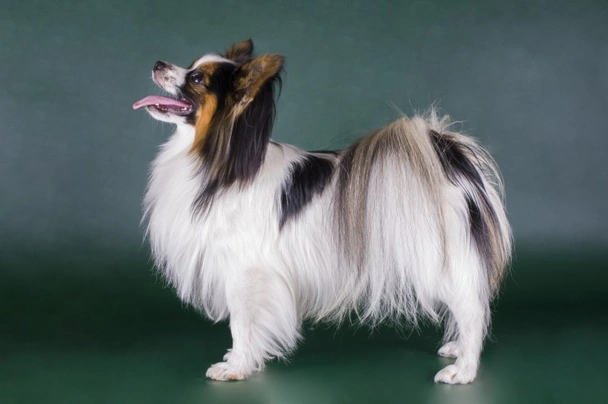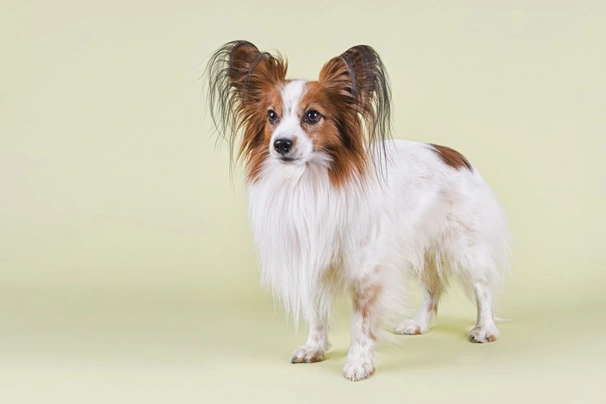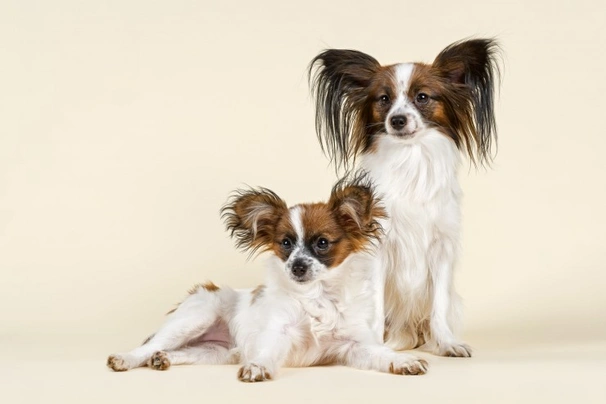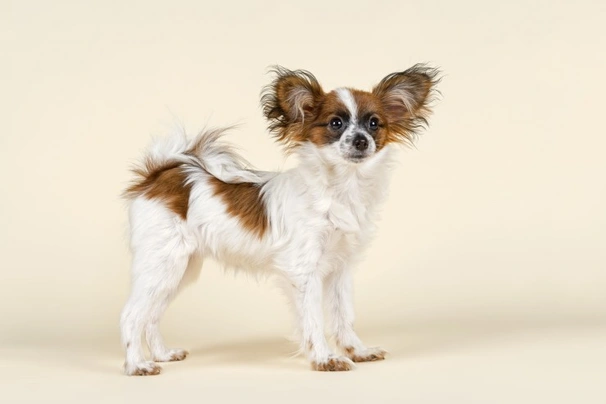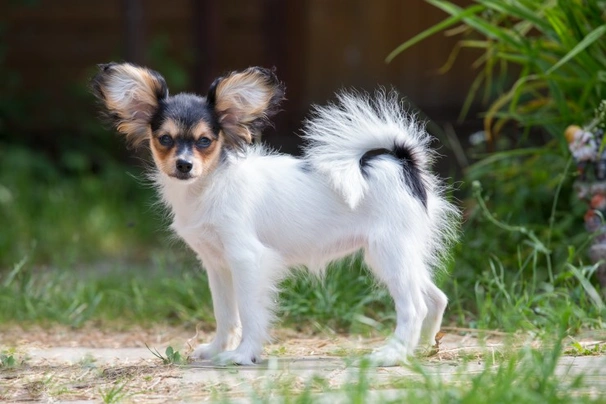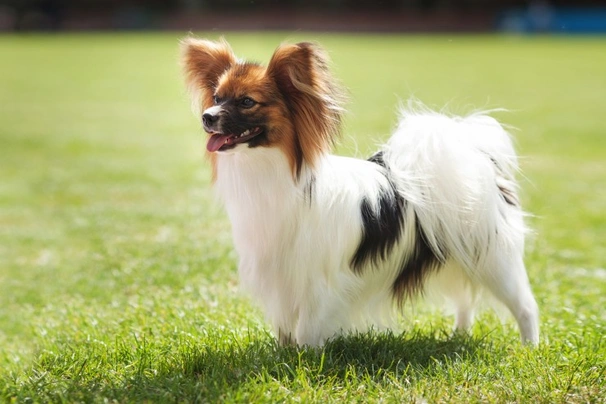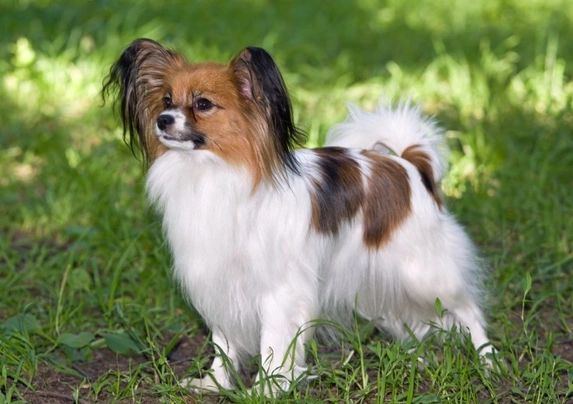Papillon
Pros
Cons
Introduction of the Papillon
The Papillon is a distinctive little dog renowned for its butterfly-like ears, from which it derives its name—Papillon meaning "butterfly" in French. With an elegant, delicate appearance reminiscent of continental toy spaniels, these vivacious dogs have captivated dog lovers worldwide. Ranked among the top breeds for intelligence, pubs combine charm, agility, and keen alertness, making them much more than just pretty faces. One of their unique traits is that puppies within the same litter may have either erect or dropped ears, further showcasing the breed's fascinating variety.
Originally cherished as companion dogs for European nobility, the Papillon today serves primarily as an affectionate family pet and a competitor in canine sports such as agility and obedience. Their small size belies their spirited and confident nature, bringing joyful energy to homes that can provide ample companionship and mental stimulation.
Physically, the Papillon is dainty yet robust, with a finely pointed muzzle, large fringed ears, and a luxurious single coat known for its silky texture and distinctive white base marked with assorted colour patches. Temperamentally, they are affectionate, intelligent, and adaptable, thriving best under an owner who is attentive, patient, and consistent in training. These dogs suit active individuals or families who can meet their moderate exercise needs and provide frequent mental engagement to prevent boredom.
Caring for a Papillon entails regular grooming to maintain their glossy coat, ensuring daily exercise that balances brisk walks with indoor play, and vigilant socialisation to nurture well-rounded behaviour. While they make excellent pets for many, prospective owners should be aware of their need for companionship and sensitivity to abandonment. Their high intelligence and alertness also mean early, positive training is essential to harness their spirited personality constructively.
Perfect For
The Papillon is perfect for those seeking a smart, responsive companion dog with a lively personality but who still appreciates indoor comfort. Their suitability for apartment living paired with their manageable exercise requirements makes them ideal for urban dwellers. First-time dog owners can find the breed rewarding due to its eagerness to please and trainability, whilst active families will appreciate their agility and playful nature.
Key Considerations
Potential owners must consider that despite their small stature, Papillons require consistent mental stimulation and can suffer from separation anxiety if left alone too long. They need ongoing grooming commitments to avoid coat mats and shedding. Given their delicate bone structure, care with rough handling is necessary. Finally, their barking tendencies require early management to prevent nuisance behaviours.
History of the Papillon
With origins traced back over 700 years, the Papillon is a breed steeped in history, its exact beginnings wrapped in a charming mystery shared by both France and Belgium, who each claim the breed as native to their countries. Its ancestors are believed to descend from European Toy Spaniels, with possible influences from Asian toy breeds such as the Japanese Chin. Throughout the 16th century, these small spaniel-type dogs were beloved companions of European royal courts and nobility, prized for their elegance and lively character.
Early Development
Early dwarf spaniels, known as "Phalene" for their moth-like dropped ears, were prevalent during the reign of Louis the Great. Occasionally, puppies with erect, feathered ears appeared, which some speculate resulted from crossbreeding with small spitz-type dogs. This dichotomy persists today, as litters often contain both ear types. The breed’s coat transitioned from solid colours in early iterations to the white base with colour patches that characterises the modern Papillon.
Modern Recognition
The Papillon arrived in the United Kingdom in 1901 and was officially recognised by The Kennel Club in 1923. Since then, the breed's popularity has grown steadily, with dedicated breed clubs and aficionados promoting its health, temperament, and versatility. The American Kennel Club followed suit with recognition in 1935, cementing the breed's international presence. During wartime, although small, Papillons were appreciated for their alertness and agility, traits that made them effective as ratters and companions. Their enduring legacy continues in dog sports, shows, and as cherished pets globally.
Appearance of the Papillon
Size and Build
The Papillon is a compact, dainty toy breed standing typically between 20 to 28 cm in height at the withers for both males and females. Weights generally range from 3.2 to 4.5 kg, with males tending to be slightly heavier than females. Their bodies are longer than tall, featuring a level topline and well-sprung ribs, giving them a balanced and elegant silhouette. Strong yet delicate bone structure supports well-muscled, agile limbs with fine bone. Their feet are fine, hare-like, and elongated with long tufts of hair growing between the toes, adding to their refined appearance.
Coat and Colours
The Papillon's coat is a single-layered, silkily fine and very long coat that lays flat on the back and sides but forms a profuse frill around the chest. The coat is short and close on the head, muzzle, and front legs, while the backs of the front legs, tail, and thighs are adorned with longer featherings. Accepted coat colours per The Kennel Club standard include a wide variety of patterns predominantly on a white base, featuring Black & White, Dark Red & White, Dark Sable & White, Lemon & White, Silver & White, Tricolour, and many others with liver and sable shading variations.
Distinctive Features
Characterised by their large, mobile ears that are heavily fringed and shaped with rounded tips, Papillons possess a slightly rounded head between their ears and a refined, pointed muzzle with a strong jaw and perfect scissor bite. Their wide-set ears are set towards the back but remain sufficiently apart to reveal their rounded skull shape. The well-feathered tail is carried high and arched over the back forming a plume that gracefully falls to one side during movement. Their gait is light, flowing, and ground-covering, with feet moving parallel, reflecting their agility and elegance.
Gender Differences
Males are generally marginally taller and heavier than females but share the same refined structure and colouring standards. Temperamentally, males can sometimes exhibit slightly more spirited confidence, while females may be a little more reserved but equally affectionate and responsive.
Temperament of the Papillon
Core Personality Traits
Despite their petite size, Papillons are remarkably confident and vivacious dogs with a highly intelligent and alert nature. Their sharp minds and eagerness to please mean they often become the centre of attention with their playful and affectionate demeanor. They bond closely with their families and thrive on interaction and involvement in daily activities, making them excellent companions for attentive owners.
Social Behaviour
Though naturally wary and vigilant towards strangers, Papillons are rarely aggressive, typically opting to bark at newcomers to alert their owners and then maintain distance. They enjoy the company of other dogs with proper socialisation but may display dominance behaviours if not introduced early. Papillons possess a strong prey drive, stemming from their historical ratting background, which necessitates caution around smaller pets and wildlife, especially if unsupervised.
Working Instincts
Historically bred as ratters and companions, Papillons have retained a high level of focus and agility. They excel in dog sports such as agility, obedience, and even hearing dog work, reflecting their alertness and quick reflexes. Their natural curiosity and intelligence require consistent mental challenges to prevent boredom-related destructive behaviour.
Common Behavioural Challenges
Their small size sometimes leads to a tendency for "small dog syndrome" if not managed early, resulting in wilfulness and stubbornness. Separation anxiety is also common, given their strong attachment to owners, which can manifest as barking, destructiveness, or nervous behaviour if left alone too long. Persistent barking is another trait seen in some individuals, requiring gentle yet firm training to moderate.
Intelligence / Trainability of the Papillon
The Papillon is highly intelligent and eager to please, making it an exceptionally trainable breed when approached with consistency and patience. Early training is crucial, ideally starting between 7 to 8 weeks of age, focusing on basic obedience and gentle socialisation to ensure well-adjusted adult behaviour. Puppies learn commands rapidly but need short, engaging sessions to retain focus.
Puppy Training Priorities
House training should begin promptly with a structured routine and frequent outdoor opportunities. Introducing a Papillon puppy to various environments, sounds, people, and animals from an early age helps prevent fearfulness and dominance issues. Teaching basic commands such as "come," "sit," "stay," "quiet," and "leave it" lays the groundwork for good behaviour and control.
Training Methods That Work
Positive reinforcement with treats, praise, and play is the most effective motivator. Papillons respond well to consistent commands and require all family members to use unified signals. Short sessions of 10-15 minutes several times daily keep training fun and prevent boredom. Redirecting unwanted behaviours with distraction and reward encourages obedience without stress.
Advanced Training Potential
Papillons excel in agility and canine sports, leveraging their natural quickness and smartness. Some are trained as therapy or hearing dogs, showcasing their versatility. Advanced obedience and trick training provide excellent mental stimulation to keep these clever dogs engaged.
Common Training Mistakes
Over-indulgence or inconsistent rules can lead to "small dog syndrome," resulting in wilful or overly bossy behaviour. Harsh corrections should be avoided as Papillons are sensitive and may become anxious or fearful. Skipping early socialisation risks problematic behaviour patterns and fearfulness in adulthood.
Children and other
Age-Specific Interactions
Due to their small size and delicate build, Papillons are not ideally suited for households with very young children or toddlers, who may unintentionally handle them roughly. When older children and teenagers interact with Papillons, supervision remains important to ensure gentle handling and respect for the dog's boundaries.
Teaching Children Proper Interaction
Children should be taught to approach Papillons calmly, avoid sudden movements, and never pull ears, tails, or fur. Emphasising respectful and gentle touch helps prevent snapping or defensive behaviour in dogs. Clear rules about when and how to play should be established early in the household.
Breed-Specific Considerations
The breed’s high energy and playful nature mean they enjoy interactive games with children, but the fragility of their bones and predisposition to "small dog syndrome" require all family members to be mindful of handling. Their occasional vocal tendencies also need proactive training to limit excessive barking around children.
Creating Safe Environments
Supervised play areas free from hazards and safe retreats where the Papillon can rest undisturbed are essential. This helps avoid stress and incidents that could arise from feeling cornered or overwhelmed. Older children can be encouraged to help provide routine care and exercise, balancing responsibilities and bonding.
Health of the Papillon
Breed-Specific Health Conditions
The Papillon is generally a healthy and robust breed with a life expectancy of 13 to 15 years. However, there are several hereditary conditions to be aware of. Prominent among these are Von Willebrand’s disease, a genetic blood clotting disorder; luxating patella which affects the knee joint; and progressive retinal atrophy causing vision loss. Cataracts and open fontanelle are also reported, alongside common issues in small breeds like dental disease, allergies, and mitral valve disease.
Genetic Testing Requirements
Responsible breeders test for Von Willebrand’s disease using DNA screening and participate in eye testing schemes such as the BVA/KC/ISDS eye scheme to catch progressive retinal atrophy and cataracts. Patellar luxation testing is advised through breed club programmes. The BAER test is recommended for congenital deafness identification. These tests help ensure health-conscious breeding and reduce inherited diseases.
Preventive Healthcare Schedule
Puppies should receive their primary vaccinations at 10-12 weeks and subsequent boosters as recommended by vets. Regular dental checks, parasite control, and routine health screenings are important for maintaining longevity and quality of life. Senior Papillons require adapted care for arthritis, weight management, and sensory decline.
Insurance Considerations
Given the breed’s common health concerns, insurance policies covering hereditary conditions, dental care, and emergency treatment are advisable. Pet insurance premiums typically range between £20 and £45 monthly depending on the level of coverage and location within the UK.
Caring for the Papillon
Daily Care Routine
Caring for a Papillon involves daily grooming including brushing to prevent mats, checking ears for wax build-up, and maintaining dental hygiene. Exercise should include at least two walks daily combined with indoor play and mental stimulation, using puzzle toys or training games. Feeding should follow a consistent schedule with attention to weight management. Routine vet visits for vaccinations and health monitoring are essential to catch early signs of health issues.
Living Environment Needs
While well-suited to apartment life due to their small size, Papillons benefit from access to a secure garden where they can safely run and explore. Their fragile bones necessitate gentle handling and the avoidance of activities that risk injury such as jumping excessively or rough play. Temperature sensitivity means careful observation in extremes of weather, with shaded rest areas in summer and warm bedding in winter.
Seasonal Care Adjustments
Summer care includes protection from heatstroke and ensuring fresh water availability at all times. In winter, coat care intensifies to protect against cold, and outdoor time may be shortened for elderly dogs or those with arthritis. Regular nail care is crucial year-round to prevent discomfort or damage.
Senior Care Adaptations
Older Papillons need adjusted diets rich in digestible proteins and lower fat, along with gentle exercise to maintain muscle tone without strain. Attention to arthritis and mobility aids such as ramps or non-slip bedding can enhance comfort. Mental stimulation through scent games or gentle training supports cognitive function in senior years.
Grooming of the Papillon
Coat Maintenance Schedule
The Papillon's single, long silky coat requires daily brushing to prevent tangles and mats. Special attention should be given to the featherings on ears, tails, and legs where knots can easily form. Females may experience heavier shedding following their heat cycles, while males shed more noticeably once a year, necessitating extra brushing during these periods.
Professional Grooming Requirements
Professional grooming every 6 months is recommended for trimming and maintaining coat health, especially to keep the profuse frill around the chest and feathering in good condition. Grooming costs vary but budgeting around £40 to £60 per visit is reasonable. Some owners opt for trim styles that reduce maintenance between professional appointments.
Home Grooming Techniques
Home grooming should use quality slicker and soft bristle brushes, grooming gloves, and occasionally a detangling spray. Nail trimming, ear cleaning, and dental care form essential parts of the routine. Small scissors with rounded tips must be used carefully for delicate trimming. Regular ear checks prevent wax build-up and infections.
Common Grooming Challenges
Maintaining a tangle-free coat year-round is the primary challenge, particularly during shedding seasons. Papillons may suffer from black hair folliculitis requiring veterinary intervention if skin irritation develops. Owners must be vigilant and proactive in grooming to ensure their dog's comfort and skin health.
Exercise of the Papillon
Daily Exercise Requirements
Despite their small stature, Papillons demand moderate daily exercise to remain physically and mentally fit. A minimum of 40 to 60 minutes of activity per day is recommended, split between a shorter morning walk and a longer, stimulating afternoon outing. Their energetic nature benefits greatly from off-lead time in secure gardens to release pent-up energy.
Suitable Activities
Papillons excel in agility, obedience, and other canine sports, which cater to their intelligence and agility. Interactive games, puzzle toys, and training sessions further enrich their mental wellbeing. Activities like fetch, hide and seek, and mini obstacle courses suit them well. Due to their prey drive, safe environments and secure fencing are critical for their off-lead enjoyment.
Exercise Restrictions
Puppies require limited exercise to protect their developing joints and bones, avoiding stairs, jumping, and overexertion. Fragile bones necessitate careful handling to prevent injury. Older dogs may require reduced activities and more rest to manage arthritis and endurance.
Mental Stimulation Ideas
Regular mental challenges are vital. Puzzle feeders, scent games, advanced obedience, and trick training keep a Papillon's keen mind engaged. Rotating toys and introducing new challenges prevent boredom and undesirable behaviours.
Feeding of the Papillon
Nutritional Requirements
Perri Papillons require a nutritionally balanced diet suited to their size, activity level, and life stage. Puppies benefit from diets higher in protein and fat for growth, while adults require moderate fat and calorie intake to maintain a healthy weight. Protein content around 20-25%, fat at 10-15%, and controlled levels of calcium and phosphorus support bone health. Special attention should be given to high-quality, digestible formulations that avoid fillers.
Feeding Schedule Guidelines
Puppies should be fed 3 to 4 small meals daily, gradually transitioning to 2 meals per day by adulthood. Portion sizes must be adjusted according to the puppy’s build and activity, with monitoring to avoid obesity. Adult dogs typically require between 50-90 grams of food daily, depending on weight and exercise.
Special Dietary Considerations
Care should be given to any food sensitivities or allergies, with vet guidance on suitable hypoallergenic options if needed. Supplements such as omega-3 fatty acids can support coat and joint health. Avoid overfeeding treats to reduce the risk of obesity.
Weight Management
Maintaining an ideal body condition is crucial for Papillons, as excess weight strains their joints and can exacerbate health problems. Regular weight checks and adjusting diet or exercise accordingly help prevent obesity and related ailments like collapsing trachea.
Papillon price
When considering purchasing a Papillon puppy, prices typically range between £800 and £1,500 depending on the breeder’s reputation, lineage, and the puppy’s quality, with show-quality puppies commanding higher prices. Pet-quality Papillons tend to be at the lower end of this range. Location and demand can also influence prices, with some regional variation seen across the UK.
Initial setup costs include essentials such as quality feeding bowls, grooming tools, crate or pen, toys, and bedding, estimated to cost between £150 and £300 before bringing your puppy home.
Ongoing monthly expenses are generally moderate, averaging between £50 and £80 for high-quality dog food, routine grooming, and regular veterinary care, including vaccinations, flea and worm treatments. Insurance premiums vary, with basic policies costing around £20-£25 monthly, while comprehensive lifetime cover can exceed £40 a month depending on age and cover level.
Lifetime ownership costs for a Papillon are projected in the range of £6,000 to £8,000, factoring in food, veterinary care, grooming, training classes, and unexpected health needs. Responsible budgeting and choosing a reputable, health-tested breeder can help minimise costs related to health issues.
You can find Papillon for sale on Pets4Homes to explore current puppy listings and pricing directly.
Buying advice
When searching to find Papillon for sale, prospective owners should adopt a careful and informed approach to ensure ethical acquisition and a healthy puppy. Beware of online scams offering unrealistically low prices and never pay deposits for unseen puppies. Visiting the breeder in person to meet both the puppy and its mother, alongside verifying the living conditions, is essential.
Finding Ethical Breeders
Choose breeders committed to responsible practices who adhere to Kennel Club guidelines, including the limited number of litters per dam and age restrictions. Ask for health testing certificates for conditions such as progressive retinal atrophy, Von Willebrand’s disease, and patellar luxation.
Health Testing Verification
Ensure the puppy's parents have been screened through recognised testing schemes like the BVA/KC Eye Scheme and DNA tests for hereditary diseases. Check registration papers and microchip details to avoid illegal or unethical breeders.
Puppy Selection Process
Observe puppies for confident, friendly demeanour and alertness. Temperament testing and health checks can reveal promising individuals suited to your household. Avoid puppies that are excessively shy or overly aggressive at a young age.
Contract and Guarantee Review
Always review contracts detailing health guarantees, return policies, and spay/neuter agreements. Red flags include vague paperwork or reluctance to provide references.
Rescue and Adoption Options
Consider adoption from breed-specific rescues or shelters where Papillons may be available. Adopting helps provide a second chance to deserving dogs and supports responsible dog ownership.
